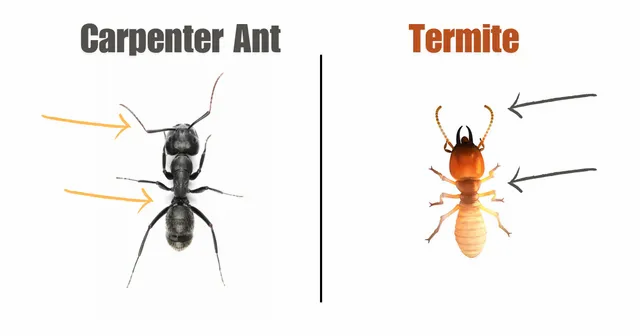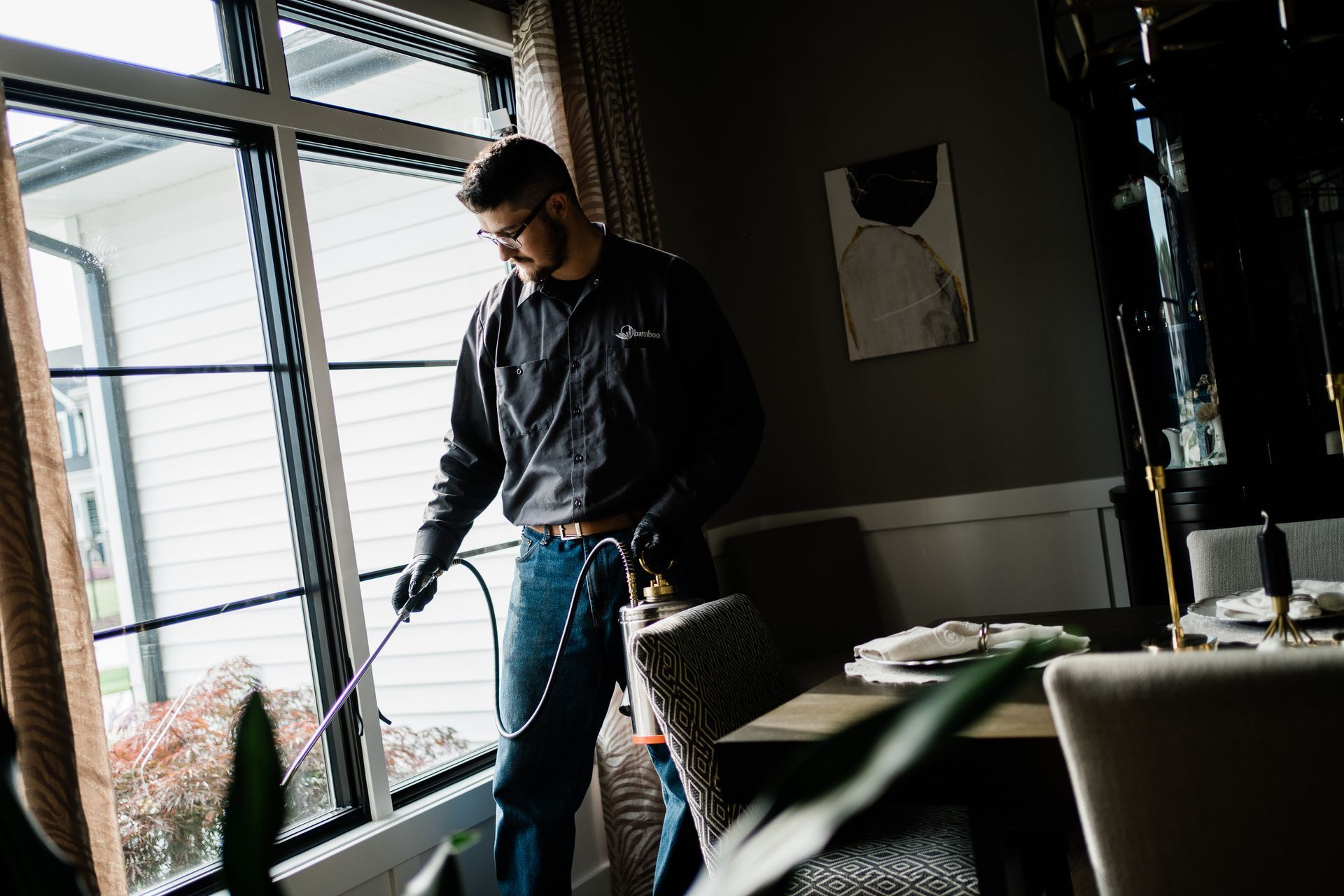Carpenter Ants vs Termites
Carpenter Ants vs. Termites: Key Differences You Should Know
If you’re trying to figure out the main differences between carpenter ants and termites, you’re not alone—many people confuse the two due to their similar behavior and appearance. However, there are distinct differences that set these pests apart in terms of their looks, habits, and how to handle an infestation. Recognizing these differences can help you protect your property from significant damage, but if you're unsure, a professional pest control service is always a good option. Let’s take a closer look at what makes carpenter ants and termites unique.
Physical Differences: Size, Shape, and Color
While both carpenter ants and termites share the basic six-legged insect structure, several noticeable features can help you tell them apart.

- Body Shape and Waist: One of the quickest ways to differentiate between the two is by looking at their waist. Carpenter ants have a narrow, pinched waist that clearly separates their body into three distinct segments. In contrast, termites have a more uniform, straight-sided body with only two segments, lacking that "pinched" look.
- Antennae Structure: Carpenter ants have bent or "elbowed" antennae that angle outward before pointing forward. Termites, however, have straight, bead-like antennae that tend to droop downward, giving them a different profile.
- Wings (If Present): When it comes to winged carpenter ants and termites, you can also spot differences. Carpenter ants have two pairs of wings with a noticeable size difference—the front wings are larger than the hind wings. On the other hand, termites have four wings of equal size, which can make it harder to distinguish the front from the back.
- Color Variations: Carpenter ants are typically darker in color, ranging from black to reddish-brown, depending on the species. Termites, by contrast, often have a lighter, almost translucent appearance, with colors ranging from creamy white to dark brown depending on their role within the colony.
While both carpenter ants and termites may seem similar at first glance, the differences in their body structure, antennae, and wing patterns are key identifiers. These details can make it easier to tell which pest you’re dealing with, allowing you to take the right steps in addressing the infestation.
Behavioral Differences Between Carpenter Ants and Termites
A key difference between carpenter ants and termites lies in how they interact with wood. This distinction often confuses homeowners, as both insects are found around wood, but their behavior toward it varies significantly.
Carpenter Ants: Nesting, Not Eating
Carpenter ants don’t actually consume wood; instead, they burrow into it to create nests. They use wood primarily for shelter, carving out tunnels and galleries, which can lead to structural damage, though it's typically less severe than termite damage. Unlike termites, carpenter ants are attracted to human food, so you might spot them raiding your kitchen or pantry in search of sweets or proteins. The wood itself is more of a safe, comfortable home for carpenter ants than a food source.
Termites: Wood as a Food Source
Termites, on the other hand, feed on the wood they inhabit, making them much more destructive. They rely on cellulose, the primary component of wood, as their food source. Over time, termites can consume entire support beams, causing serious damage that might go unnoticed until it's too late. If you notice signs of sagging floors or ceilings that resemble water damage but have no visible water issues, termites may be to blame. Their relentless appetite makes them a more dangerous threat to homes.
Detecting the Infestation
Locating carpenter ants and termites also differs significantly. Carpenter ants are more visible because they venture away from their nests in search of food, leaving behind signs like small piles of frass (sawdust-like debris) as they burrow through wood. This makes them easier to detect early on.
Termites, however, are more elusive. They tend to stay close to their nests, rarely wandering out in search of food since their food source is the wood itself. This hidden activity makes termite infestations harder to spot and, if undetected, allows them to continue damaging the structure over long periods, sometimes going unnoticed until significant destruction has occurred.
Why Termites Pose a Greater Risk
While carpenter ants can damage wood structures, termites pose a much larger threat due to their wood-eating habits. Left unchecked, termites can destroy a house’s structural integrity, leading to floors and ceilings sagging or even collapsing.
In both cases, early detection and professional pest control are crucial. If you suspect an infestation, whether from carpenter ants or termites, contact a local pest control company for an expert assessment and tailored solutions to protect your home.

How to Identify an Infestation of Carpenter Ants vs. Termites
Wondering if you’re dealing with a carpenter ant or termite infestation? These pests have different habits and leave behind distinct signs of their presence. Here are a few key indicators to help you figure out what’s going on. If you’re unsure, it’s always wise to reach out to a professional pest control service, as both pests can cause serious damage if left unchecked.
Sawdust and Frass
If you find small piles of sawdust-like material near wooden structures, you might be dealing with carpenter ants. This material, called frass, is essentially the waste produced when carpenter ants burrow into wood to create their nests. Termites, on the other hand, leave no wood shavings behind because they consume the wood as their primary food source, making them less likely to leave this kind of telltale debris.
Mud Tunnels
One clear sign of termites is the presence of mud tubes on the exterior or interior walls of your home. Termites build these tunnels as protective highways between their colony and food sources. The mud tubes are often found near a home's foundation, providing termites with a safe route to the wooden structures they’re consuming. Carpenter ants don’t build these tunnels, so if you see them, it’s a strong sign of termite activity.
Wood Damage
Carpenter ants and termites damage wood in different ways. Termites completely consume wood, leaving it hollow and weakened. If you tap on the wood and it sounds empty or if you see buckling, sagging, or blistered wood, termites may be the culprit. Carpenter ants, on the other hand, carve out tunnels and galleries within the wood to build their nests. If you find wood with smooth, clean tunnels, it’s more likely the work of carpenter ants.
Dealing with Carpenter Ants and Termites
It’s important to take infestations seriously, whether you’re dealing with carpenter ants or termites. Termites, in particular, are notorious for the severe structural damage they cause over time. The longer they are allowed to infest your home, the more extensive (and expensive) the damage becomes, often leading to significant delays in home improvement or remodeling projects.
Carpenter ants, while typically less destructive than termites, can still cause problems if their colony is left unchecked. Not only can they damage wooden structures, but they may also pose health risks by contaminating food or bringing bacteria into your home.
If you think you’re facing an infestation, contacting
Kennewick Pest Control By Bamboo is your best option. Our team can help identify the type of infestation you’re dealing with and offer the most effective solution to eliminate it. Don’t let pests damage your property or threaten your family’s health. Reach out to us today for expert help. Be sure to explore our detailed FAQ section to learn more about preventing and managing common household pests!
For service call: (509) 204-3939
Copyright © 2024 - Kennewick Pest Control by Bamboo All Rights Reserved
